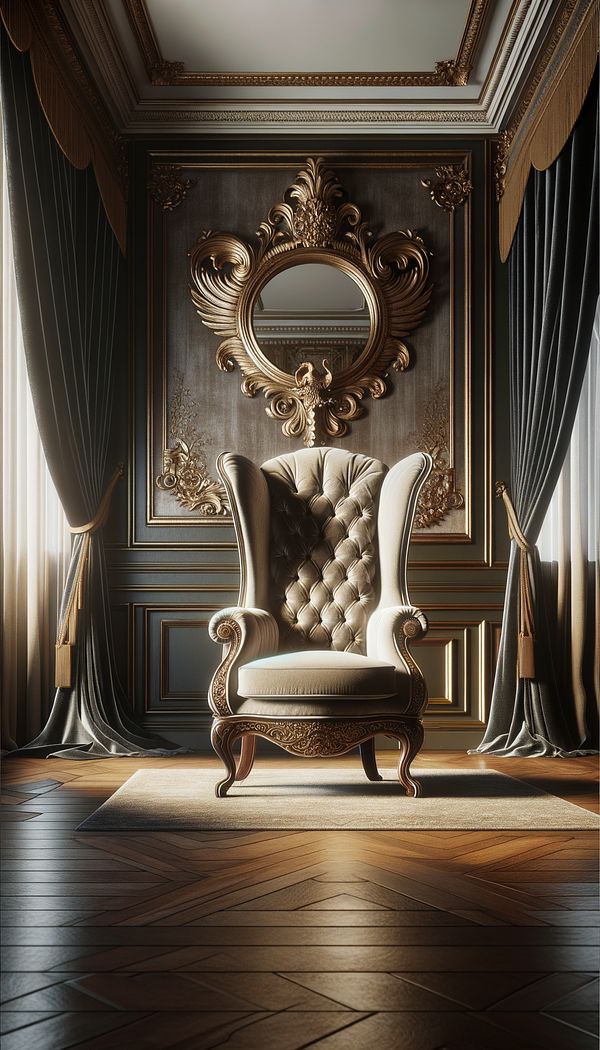What is Queen Anne?
An architectural and furniture design style that originated in the late 17th and early 18th centuries, characterized by its elegant and ornate features.
Description
What we refer to today as Queen Anne style originated during the reign of Queen Anne of England (1702-1714), but its most defining characteristics came into fashion slightly later, in the early 18th century. Known for its emphasis on elegance and ornamentation, the Queen Anne style represents a notable shift from the heavier, more robust designs of the preceding period to lighter, more graceful forms.
In interior design, the Queen Anne style is easily identifiable by its gracefully curved lines, often seen in furniture legs and armrests, and the use of rich, luxurious materials. Fabrics such as velvet and silk were prevalent, and furniture pieces were often embellished with intricate carvings, marquetry, and gilding. The style also favored asymmetrical shapes and the incorporation of motifs like shells, flowers, and leaves, which were thought to reflect nature and sophistication.
Over time, the Queen Anne style evolved, especially in the United States during the late 19th century, where it became associated with architectural elements such as turrets, wrap-around porches, and gabled roofs. However, the core elements of elegance, ornamentation, and the use of fine materials have remained hallmarks of the style.
Usage
Examples of the Queen Anne style in interior design include the iconic Queen Anne chair, known for its curved cabriolet legs, cushioned seats, and typically a wingback design. In architecture, the style is often seen in historical homes with distinctive asymmetrical facades, bay windows, and decorative trim. The combination of these features creates a sense of refined luxury and sophistication in both furniture and buildings.
FAQs
-
Is Queen Anne style exclusive to furniture?
No, the Queen Anne style is not exclusive to furniture; it also encompasses architecture, where it's known for elegant and ornate features including turrets, gabled roofs, and wrap-around porches.
-
How does the Queen Anne style differ from Victorian style?
While both styles are known for their ornate qualities, the Queen Anne style is distinguished by its lighter, more graceful approach, focusing on curved lines and elegance, whereas Victorian style often incorporates a broader range of elements and can be heavier in terms of decoration.
-
Can Queen Anne style elements be incorporated into modern interiors?
Absolutely! Incorporating Queen Anne style furniture or decorative pieces can add an element of sophistication and historical charm to modern interiors. The key is to blend these pieces thoughtfully with contemporary decor to maintain a cohesive look.
Practical Application
To incorporate Queen Anne style elements into your interior design, focus on selecting furniture or decorative pieces that echo its characteristic graceful curves and rich detailing. A single Queen Anne chair or an ornamental mirror can serve as a focal point in a room, adding a touch of elegance and historical depth. Remember, balancing these ornate pieces with more understated, modern furnishings will help create a sophisticated, yet harmonious space.
-
Architectural Elements199 articles
-
Design Styles478 articles
-
Furniture Types599 articles
-
Decorative Objects240 articles
-
Textiles & Upholstery252 articles
-
Trundle BedA bed designed to save space, which stores an additional bed underneath.
-
ChifforobeA chifforobe is a piece of furniture that combines a wardrobe with a chest of drawers.
-
CastersCasters are small wheels or rollers designed to be attached to the bottom of an object to enable it to move easily.
-
Post-ModernismPost-Modernism is a diverse style and concept in interior design that emerged as a reaction to the strict rules of modernism, focusing on freedom of expression, eclectic influences, and a blend of historical and contemporary elements.
-
CoverletA coverlet is a lightweight, decorative bedspread.
